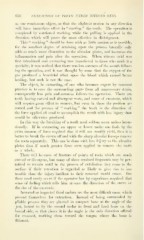Page 638 - My FlipBook
P. 638
636 EXTRACTION OF TEETH UNDER NITROUS OXID.
as one continuous object, so tliat the slightest motion in any direction
will have ininiediate efh'ct in " starting " the tooth. The operation is
completed hy continued working while the pulling is applied in the
direction which will prove the most effective in dislodgment.
This " working" should be done with as little motion as is possible,
for the smallest degree of straining upon the process laterally only
adds so much more distention to the alveolar plates, and increases the
inflammation and pain after the operation. When nitrous oxid was
first introduced antl extracting was transferred to those who made it a
s[)ecialty, it was noticed that there was less soreness of the mouth follow-
ing the operation, and it was thought by some that the oxygen of the
gas produced a beneficial effect upon the blood which caused better
healing, but such is not the case.
The object, in extracting, of one who becomes expert by constant
practice is to save the surrounding parts from all unnecessary strain,
consequently less pain and soreness follows the operation. There are
teeth having curved and divergent roots, and cases of exostosis, which
will require great effort to remove, but even in these the position as-
sumed and the process of " w^orking " the tooth in the direction of
the force applied all tend to accomplish the result with less injury than
Avould be otherwise produced.
In this way the breaking of a tooth need seldom occur unless inten-
tionally. If in extracting an upper or lower molar one finds by the
extra amount of force required that it will not readily yield, then it is
better to break the crown off and with the sharp alveolar forceps remove
the roots separately. This can be done with less injury to the alveolar
plates than if much greater force were applied to remove the tooth
as a whole.
There will be cases of fracture of points of roots which are much
curved or divergent, but many of these retained fragments may be per-
mitted to remain until in the process of exfoliation they come to the
surface if their retention is regarded as likely to give rise to less
trouble than the injury incident to their removal would cause. But
these need rarely occur if the operator has by experience acquired that
sense of feeling: which tells him at once the direction of the curve or
the size of the exostosis.
Inverted or impacted third molars are the most difficult cases which
present themselves for extraction. Instead of being surrounded by
pliable process they are planted in compact bone at the angle of the
jaw, bound in by the second molar in front and hard bone on the
buccal side, so that above it in the angle is the only direction offered
for removal, working them toward the tongue where the bone is
thinnest.


